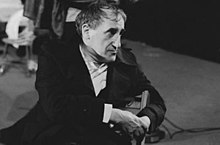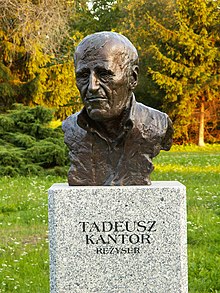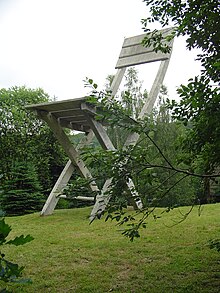Tadeusz Kantor
Tadeusz Kantor | |
|---|---|
 Tadeusz Kantor | |
| Born | 6 April 1915 |
| Died | 8 December 1990(aged 75) |
| Nationality | Polish |
| Occupation(s) | Theater director, artist |
| Notable work | Dead Class;Wielopole, Wielopole |
Tadeusz Kantor(6 April 1915 – 8 December 1990) was a Polishpainter,assemblageandHappeningsartist, set designer andtheatre director.Kantor is renowned for his revolutionary theatrical performances in Poland and abroad. Laureate ofWitkacy Prize – Critics' Circle Award(1989).
Life and career
[edit]Kantor was born to Marian Kantor-Mirski and Helena Berger. His family were staunch Catholics. His mother was related to composer and conductorKrzysztof Penderecki,through her German father. Born inWielopole Skrzyńskie,Galicia(then in Austria-Hungary, now inPoland), Kantor graduated from theCracow Academyin 1939. During theNazi occupation of Poland,he founded the Independent Theatre, and served as a professor at theAcademy of Fine Arts in Krakówas well as a director of experimental theatre inKrakówfrom 1942 to 1944. After the war, he became known for hisavant-gardework in stage design including designs forSaint Joan(1956) andMeasure for Measure(1956). Specific examples of such changes to standard theatre were stages that extended out into the audience, and the use ofmannequinsas real-life actors.
In 1955, with a group of visual artists disenchanted with the growing institutionalization of avant-garde, he formed a new theatre ensemble calledCricot 2.In the 1960s, Cricot 2 gave performances in many theatres in Poland and abroad, gaining recognition for their stagehappenings.His interest was mainly with theabsurdistsand Polish writer and playwrightStanisław Ignacy Witkiewicz(also known as "Witkacy" ). Stage productions of Witkacy's playsThe Cuttlefish(1956) andThe Water Hen(1969) were regarded as his best achievements during this time. A 1972 performance ofThe Water Henwas described as "the least-publicised, most talked-about event at theEdinburgh festival".[1]


Dead Class(1975) was the most famous of his theatre pieces of the 1970s.[2][3]A TV-Movie of the production was made in 1977, directed byAndrzej Wajda.[4]In that play, Kantor himself played the role of a teacher who presided over a class of apparently dead characters who are confronted by mannequins representing the characters' younger selves. He had begun experimenting with the juxtaposition of mannequins and live actors in the 1950s.
His later works of the 1980s were very personal reflections. As inDead Class,he would sometimes represent himself on stage. In the 1990s, his works became well known in theUnited Statesdue to presentations atEllen Stewart'sLa MaMa Experimental Theatre Club.
Throughout his life, Kantor had an interesting and unique relationship withJewish culture;despite being a nominalCatholicKantor incorporated many elements of what was known as "Jewish theatre"into his works.
Kantor died in Kraków.
The new Center for the Documentation of the Art of Tadeusz Kantor,Cricotekawas opened in Krakow in 2014.
Major manifestos and writing
[edit]- The Autonomous Theatre(1963)
- Theatre Happening: The Theatre of Events(1967)
- The Informel Theatre(1961)
- The Zero Theatre(1963)
- The Theatre of Death(1975)
Productions with Cricot 2
[edit]- The Cuttlefish(1956)
- The Country House(1961)
- The Madman and the Nun(1963)
- The Water Hen(1965)
- Dainty Shapes and Hairy Apes, or the Green Pill(1972)
- The Dead Class(1975)
- Wielopole, Wielopole(1981)
- Let the Artists Die(1985)
- Macchina dell'amore e della morte(1987)
- I Shall Never Return(1989)
- Today is my Birthday(1990)
See also
[edit]References
[edit]- ^Ellis, Samantha (13 August 2003)."Water Hen, Edinburgh, August 1972".The Guardian.Retrieved10 May2020.
- ^Czerska, Karolina."The Dead Class – Tadeusz Kantor".culture.pl.Retrieved10 May2020.
- ^Romanska, Magda (2012).The Post-traumatic Theatre of Grotowski and Kantor.Anthem Press. p. 201.doi:10.7135/UPO9780857285263.029.ISBN978-0-85728-516-4.Retrieved10 May2020.
- ^Dead Class (TV Movie 1977)atIMDb
Further reading
[edit]- Kobialka, Michal, ed and trans. "A Journey Through Other Spaces: Essays and Manifestos, 1944–1990." Publisher: University of California Press, 1993.ISBN0-520-08423-3
- Kobialka, Michal, Author, ed and trans. "Further on, Nothing: Tadeusz Kantor's Theatre." Publisher: University of Minnesota Press, 2009.ISBN978-0-8166-5481-9
- Wilson, Edwin.Goldfarb, Alvin.Living Theatre: A History.Publisher: McGraw-Hill, 4th edition. August 5, 2003.ISBN0-07-256257-9
- Krzysztof Pleśniarowicz, Kantor. Artysta końca wieku, Wrocław 1997.
- Pleśniarowicz, Krzysztof, Author, Brand, William trans. "The Dead Memory Machine. Tadeusz Kantor's Theatre of Death", Publisher: Black Mountain Press. Centre for Performance Research, Aberystwyth, 2004ISBN1-902867-04-1
External links
[edit]![]() Media related toTadeusz Kantorat Wikimedia Commons
Media related toTadeusz Kantorat Wikimedia Commons
- Tadeusz Kantorat culture.pl
- CricotekaThe Centre For the Documentation of the Art of Tadeusz Kantor
- Tadeusz Kantor Foundation
- Kantor's gallery at malarze.com
- The Water Hen: Kantor, Demarco and the Edinburgh Festival at Culture.pl
- Images from “THE WATER HEN”at The Royal Scottish Academy of Art & Architecture
- Demarco European Art Foundationat theWayback Machine(archived October 25, 2006) images of Edinburgh performances by Tadeusz Kantor
- In Search of KantorDetails of show being performed in Edinburgh 2007 based on Kantor
- Cricot 2's website
- Art Signature Dictionary, genuine signature by the artist Tadeusz KantorHere are several dated examples of Tadeusz Kantor signature.
- TADEUSZ KANTOR YEAR 2015
- 1915 births
- 1990 deaths
- People from Ropczyce-Sędziszów County
- 20th-century Polish painters
- 20th-century Polish male artists
- Polish theatre directors
- Modernist theatre
- Grand Crosses 1st class of the Order of Merit of the Federal Republic of Germany
- Burials at Rakowicki Cemetery
- Theatre practitioners
- Assemblage artists
- Polish contemporary artists
- Polish male painters
- Postmodern theatre
- Recipients of the Medal of the 10th Anniversary of the People's Republic of Poland
